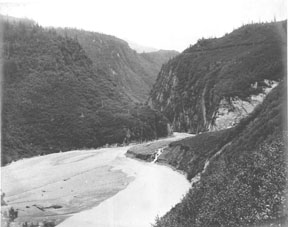

The upstream approach to Keystone Canyon, 1903. Photo by Miles Brothers. Courtesy Valdez Museum and Hitorical Archives.
Lieutenant Brookfield, Dr. Lewis, Mr. Gardner, Mr. Flemmings, and another man whose name is now forgotten, attempted, in the spring of 1898 to float through that box canyon [Keystone Canyon] on a raft. They had climbed over the mountain and had descended into this place. They were tired and hungry, and, rather than spend a day or two in climbing back to get out, they decided to go through the canyon in a few minutes.
At that time this canyon never had been explored to their knowledge, and for all they knew, they might be hurled over falls that were anywhere from five to five hundred feet high; so under those circumstances it was one of the most foolish escapades ever undertaken by men of sane minds. They built a raft of logs and willow withes; then each man armed himself with a pole, and as they shoved the raft out in the mad stream they waved their hats at nobody and yelled, "Vive Cuba Libre!" Above the sound of that mad rushing water and those madder human adventurers, the mountain echoed Alaska's greeting to the southern isle.
At the entrance of the canyon, the water piles up against a perpendicular wall, then turns squarely to the left. It was there that the voyagers were introduced to the magnitude of their undertaking. The lieutenant commanded: "Present poles!" and they did so, in a brave but futile attempt either to prevent the raft, with thousands of tons of water driving behind, from striking the rock, or to push aside that five-hundred-foot wall, buttressed with a mountain.
They and the wall met squarely; the raft dodged the problem of the irresistible missile meeting the immovable object, and continued down stream, while five men were held out in the air on the ends of their poles for a second. Then five hats were to be seen floating on the surface of the water, but not a man was visible. Ten more seconds and the men were swimming for the raft, far below the place of the first disaster. One climbed up on it, just as it was about to turn turtle, and then the raft was on top of the man. Another moment, and two men were on the raft, but the others were attempting to climb on, while it was approaching another rock wall. The man in the water below the raft had his chin resting on board in such a manner that when the raft struck the rock he would be decapitated.
One benevolent fellow, taking in the situation, did not care for the ghastly scene of having a head on board without a body attached to it, and thinking it would be preferable to the struggling mortal to drown rather than to have his head chopped off with a dull raft, he reached forth, took hold of the man's hair and, shoving him beneath, the raft glided over. The raft struck the wall, whirled and passed on, while a nearly drowned man was attempting to climb on to the rear end. Another half-minute and instead of a raft there were five separate logs with a man clinging to each one of them. They managed to find small landings, and all got out on one side, except Gardner, who crawled out on the east shore.
There were several small ravines cutting down into the canyon, and up those, by clinging to alder brush, the swimmers could climb out of the river, so they took to the mountain's sides. The remainder of the day was spent in clinging to rocky steeps, while the enraged, serpentlike river went winding and crawling beneath. Gardner, who came out of the canyon on the wrong side of the river, swam across that night. The next day they all arrived in Valdez, hatless, coatless and half starved. A year later, "Tex" and Schelly attempted to go through the same canyon on a raft, but with similar results.